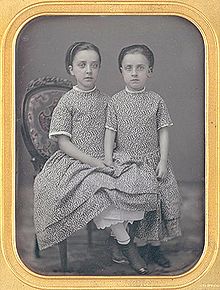Jeremiah Gurney
This article needs additional citations for verification. (June 2009) |



inside 349 Broadway
c1853
Jeremiah Gurney (October 17, 1812 – April 21, 1895), was an American daguerreotype photographer operating in New York.
Biography
Gurney worked in the jewelry trade in Saratoga, New York, but learned about the daguerrotype from Samuel Morse, took up photography, and after moving to New York City, began selling photographs alongside jewelery from his shop.[1] Different sources call him either the first photographic gallery in America and second practitioner after Morse,[1] or merely one of the first photographic galleries on Broadway.[2]
This article contains close paraphrasing of non-free copyrighted sources. (November 2022) |
He created remarkably detailed portraits, using to the full the remarkable tonal rendition of the process. He selected his clients from New York's society elite, calling them "Distinguished Persons of the Age" and eschewing the political and entertainment figures favoured by his rival, Mathew Brady. The quality of Gurney's portraits soon ensconced him as the finest daguerreotypist in Gotham.
Gurney's photographic skills received numerous accolades, including a write-up in the Scientific American of 5 December 1846. The New York Illustrated News, in an 1853 article, wrote that his establishment at 349 Broadway "consisted of nine spacious rooms, devoted exclusively to this art." In the 1840s Gurney showed his images at numerous exhibitions such as the American Institute Fair and later at the Crystal Palace in London, achieving international renown. His business flourished and in 1858 he built a three-story white marble studio at 707 Broadway to house his pictures, and it was the first building built for the sole purpose of photography in the United States.
Gurney played a leading role in the training of the first wave of pioneering photographers such as Mathew Brady, who made a name for himself as a Civil war photographer. Brady had been employed as a journeyman making jewelry cases for E. Anthony & Co., and also made display cases for Gurney's daguerreotypes.
One of the things Gurney is best known for is having taken the only known photograph of Abraham Lincoln in death.[3][4][5]
Gallery
-
Actor Nelse Seymour
-
Actor Daniel E. Bandmann
-
Swans in Central Park, New York
-
CSA General J. E. B. Stuart
References
- ^ a b http://historiccamera.com/cgi-bin/librarium2/pm.cgi?action=app_display&app=datasheet&app_id=243
- ^ Metropolitan Museum of Art
- ^ Treasures of the Abraham Lincoln Presidential Library; edited by Glenna R. Schroeder-Lein; Page 101
- ^ businessinsider.com; April 14, 2015 Retrieved October 19, 2015
- ^ americancivilwarstory.com (see appropriate caption); Retrieved October 19, 2015
Bibliography
- Peterson, Christian A. Chaining the Sun: Portraits by Jeremiah Gurney, ISBN 978-0-8166-3656-3, University of Minnesota Press (1999)




